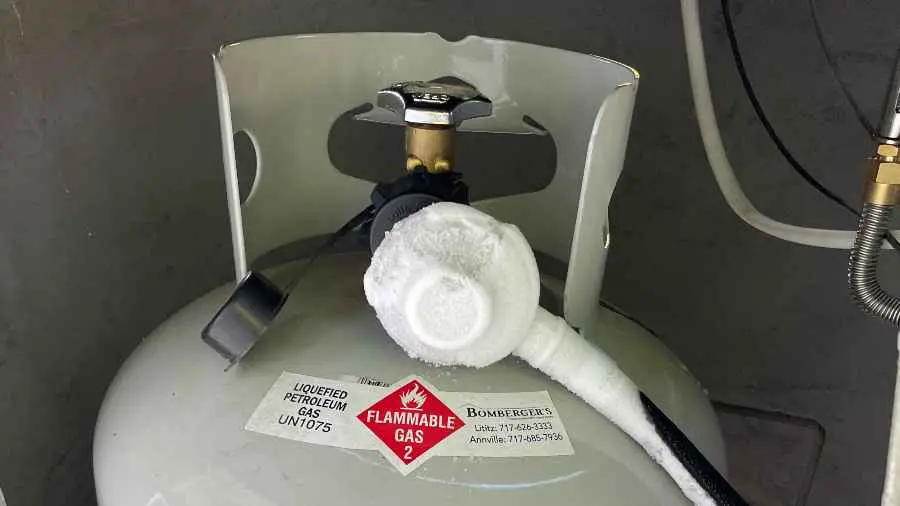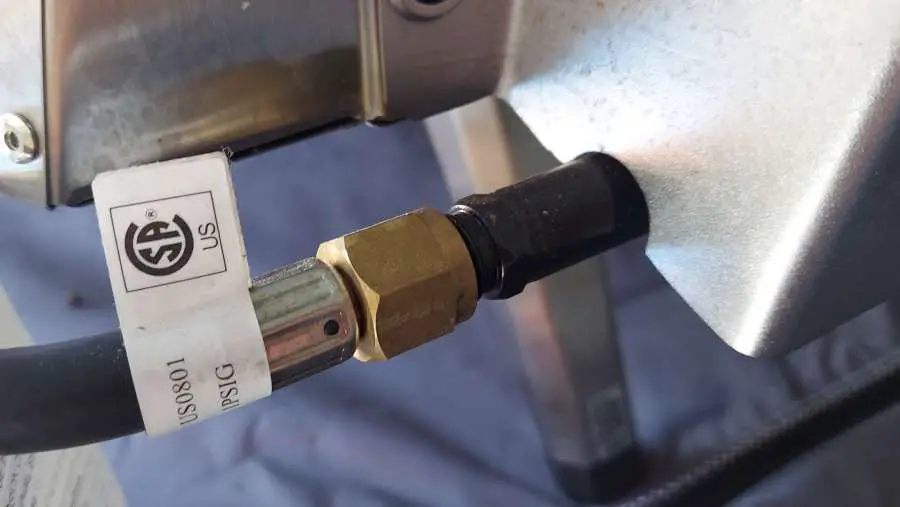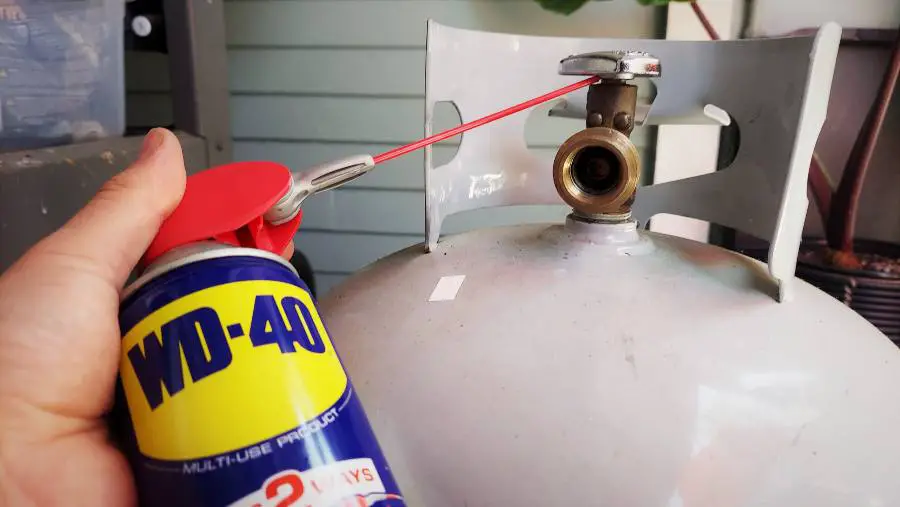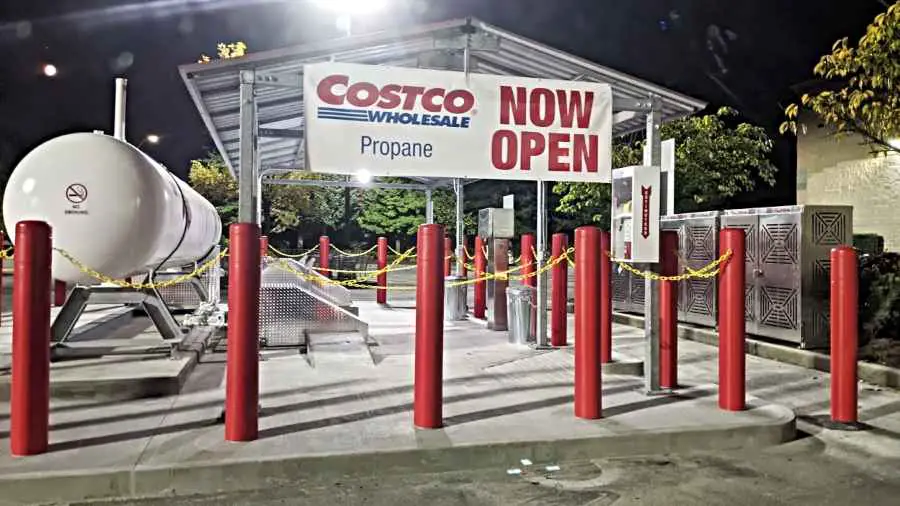Last Updated on May 23, 2024 by Dan Campbell
Propane tanks consist of three major parts: the tank, the valve, and the regulator. The regulator is one of the most important parts of a propane system. It helps control the flow of propane into your appliances, regardless of what the pressure inside the tank is. This is important as the pressure inside the tank can change drastically depending on altitude, temperature, and fill level. Your appliance, whether it’s a bbq or heater system, will require consistent pressure to operate, which is why it is crucial your propane regulator is working correctly.
The most common cause for a frozen regulator is liquid propane has some how gotten inside the regulator and has frozen due to pressure and temperature changes. To thaw a frozen propane regulator, pour hot water over the regulator or attach some hand warmers to it. Wait a few minutes and it should start working again. This should work for most cases, but I’ll go over some other options below, as well as how liquid propane might get inside a regulator, and why frost on your regulator can be normal and not a sign of it being frozen.
Why Do Regulators Freeze?
Because regulators have propane passing through them and going from a high pressure to a low pressure, the temperature will drop causing the regulator itself to become very cold. This can cause condensation to form inside and outside the regulator, and depending on temperature can cause frost to form on the outside. It is normal for frost to accumulate on the outside of a regulator during operation and will not cause any issues. So if you see frost on the outside of your regulator, but you are still getting a steady flow of propane, you do not need to do anything.

However, if liquid propane or any other liquid enters the regulator this is when you can experience freezing issues. The most common reasons liquid propane might enter a regulator is because the tank was overfilled, or the tank was horizontal allowing liquid propane to enter the regulator. Propane tanks should never be stored on their side or used horizontally (unless specifically made to be used horizontally).
Methanol and Water In Your Propane
Not only can liquid propane enter the regulator, but water vapor can also condense in extreme temperatures and freeze inside the regulator. If you filled your tank during the summer, it most likely did not contain Methanol (a chemical added for anti-freezing). When propane exits the outlet side of a regulator it changes from a high-pressure vapor to a low-pressure vapor which causes the temperature to drop dramatically. In a setting where the liquid propane is at 32F and expands to a vapor of 1.5psig, the temperature of the exiting evaporation from the regulator will be around -112F. This can cause any water in the propane to freeze when vaporized in the regulator. Because of this extreme temperature drop, methanol can be added to stop water from freezing when mixed with the propane vapor.
From a report given to the Propane Education & Research Council, if a propane tank contained even just 80ppm of water, when fueling a 100,000 BTU/hr system, 1gram of water per hour is being carried with the fuel through the regulator. Even if a portion of that liquid condenses and freezes at the regulator, a blockage can occur. This can even occur in warm ambient temperatures. However, this only occurs when there is enough water mixed with the propane. Even when the water content is around 20ppm, no water will come out of the solution. Methanol is only recommended when temperatures are expected to be below 35F.
What To Do If Your Regulator Freezes
I’m going to assume you’re in a position where your regulator is frozen, and you’re not sure if you have methanol in it. Adding methanol at this point isn’t going to do much, so you’ll need a simple solution to thaw your regulator and get it working again. Once you have it working again, I would recommend having methanol added if you’re in freezing temperatures.
Firstly, you’ll want to warm up the regulator with whatever you have available to you. Because the regulator has frozen liquid inside it, you need to simply warm this up however you can. You can use hot water, hand warmers, an electric blanket, or some form of heating tape. If you have pipe heating tape on you, then congratulations on being the most prepared person ever, but chances are you don’t.
A few ways to fix a frozen propane regulator are:
Using Hot Water
The easiest and quickest solution, as well as the most readily available, is just using hot water over the regulator. Heat up some water and slowly pour it over the regulator. You may need to do this a few times, but it should eventually warm up enough to free up blockage. Make sure to start using the propane right away to ensure there is a constant flow of propane through the regulator.
Attaching Hand Warmers
You may have some chemical-reaction heating pads or hand warmers with you, these can be activated and attached to the regulator to slowly warm up the regulator. After you’ve got it attached you can wait a few minutes and try using your appliance again, if it doesn’t start right away just wait longer and try it again. I would say it should work after 10 minutes but could take up to an hour depending on how cold it is and what size warmer you’re using. Because these are so versatile, I would recommend just buying a few and having them where you store your propane tanks in case this ever happens. They’re small enough to easily store and have a good storage life.
Wrapping An Electric Blanket or Other Electric Heating Pad
Depending on if you have electricity available, electric blankets or any other electrical heating device can work too. Simply plug in the blanket, wrap it around the regulator, and wait. If you’ve got a portable battery, you can even use a battery-powered heater option to warm up the regulator.
Hopefully you’ve got propane flowing now and you’re nice and toasty or your grill is working again. If you tried these methods and you’re still not getting propane, you may need to try resetting your propane system by purging the regulator.
Purging A Regulator (Resetting it)
Purging a regulator just means you’re removing the propane inside the regulator that might be causing the ball bearing in the bypass or flap to be stuck. If you believe your regulator is not allowing gas through and it’s not caused by frozen liquid inside, purging the regulator is a fast and easy way try and fix the issue. This can also help with any safeguards your appliance may also have on them. This can trigger due to a number of reasons, but usually, it’s due to a change in the pressure of the regulator, such as too low a pressure that causes the bypass to close thus restricting the flow of gas.
To purge or reset a regulator follow these steps:
- Fully close the valve on your propane tank
- Disconnect the propane hose/regulator from the propane tank
- Turn on all burners or valves on your appliance to clear the lines of propane
- Wait a minute and then turn off all the burners or valves on your appliance
- Reconnect the propane hose/regulator to your propane tank
- Slowly open the valve on the propane tank all the way (propane tank valves should always be fully opened when being used)
- Turn on your appliance or burners.
Make sure to always ignite your appliances that are connected to propane in the same order to ensure proper operation. The order you ignite your systems should always be:
- Make sure the appliance is off
- Open the propane tank valve all the way slowly
- Turn on the appliance
If you start the process by having your appliance or burners in the on position before opening your propane tank valve, there is a good chance you will trigger a safeguard and your appliance will not work correctly. When turning off your appliance, follow these steps in reverse order.
Planning Ahead For Next Time
With a little planning ahead you can save yourself a lot of time and headaches. If you’re planning on using your propane tanks in freezing temperatures, make sure to bring along a few of the above mentioned items, whether that’s a few chemical-reaction hand warmers or electric blankets if you’ll have electricity available. If your local propane dealer is able to add methanol to your tanks, I would highly recommend that. However, it isn’t that common for propane exchange stations to be able to do this, especially those little ones you find at gas stations. Depending on your location, you may want to contact your local propane company and ask them about where to find a location that can either sell you a tank with methanol added or where you can go to have it injected.
You can also purchase heating blankets for your entire propane tank to reduce snow build-up and keep pressure high. Making sure your propane tanks are full will also increase the pressure inside. When propane tanks are full, they have a much higher pressure when temperatures drop and are less likely to run into issues.
To reduce the chances of liquid propane or other liquids entering the regulator you should always make sure the regulator is higher than the valve. This way if any condensation forms in the pipes they will drip back down towards the valve and not inside the regulator. Also, be sure to protect your regulator from harsh weather conditions, you should never let snow build up around your propane tank or regulator.
If you’re at a home where it normally gets below freezing and you’re utilizing a company to fill your largers tanks, such as 120 gallon or 500 gallons, there is a good chance they already add methanol in the months leading up to winter. Make sure to ask about adding methanol if you plan on filling in the summer months but won’t likely refill before winter.
I hope you found this information helpful and please don’t hesitate to reach out and correct anything I mention or ask me questions.
And as always, have a great day and God bless!
Resources:




